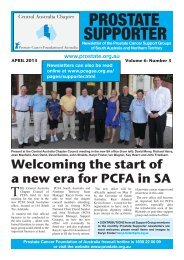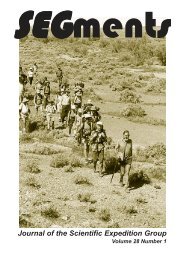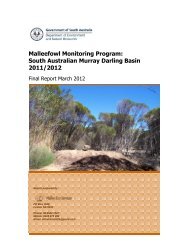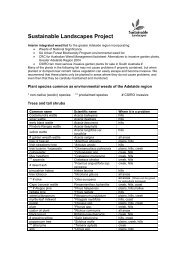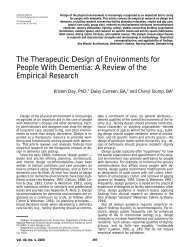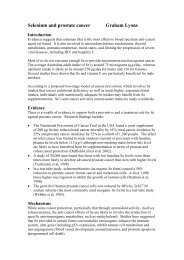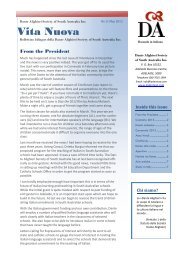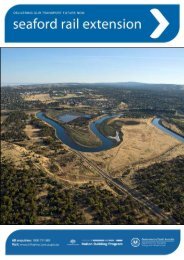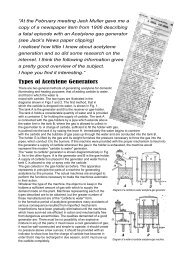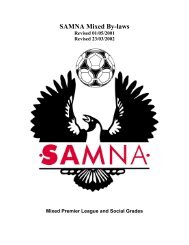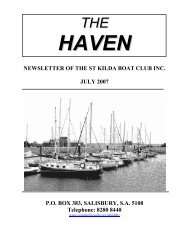Rodents in the Mount Lofty Ranges - Communitywebs.org
Rodents in the Mount Lofty Ranges - Communitywebs.org
Rodents in the Mount Lofty Ranges - Communitywebs.org
Create successful ePaper yourself
Turn your PDF publications into a flip-book with our unique Google optimized e-Paper software.
BIODIVERSITY INFORMATION<br />
<strong>Rodents</strong> <strong>in</strong> <strong>the</strong> <strong>Mount</strong> <strong>Lofty</strong> <strong>Ranges</strong><br />
Bush Rat (Rattus fuscipes)<br />
Bush Rats are native rodents. They are nocturnal and<br />
can be often located with<strong>in</strong> remnant native vegetation<br />
with a dense understorey. Bush Rats have thick grey<br />
to red brown fur with a pale cream to red underside.<br />
Diet: <strong>in</strong>sects, fungi, fruits, seeds, plant<br />
material<br />
Reproduction: spr<strong>in</strong>g, summer, autumn<br />
Size: 216 - 309 mm (head to tail)<br />
Weight: 40 - 225 g<br />
SA Status: none<br />
Swamp Rat (Rattus lutreolus)<br />
Swamp Rats are native rodents that occur<br />
predom<strong>in</strong>antly <strong>in</strong> heath and sedge habitats. Swamp<br />
Rats may be nocturnal or diurnal. They are known to<br />
construct burrows and extensive tunnels through <strong>the</strong><br />
understorey. Swamp Rats have dark grey to brown<br />
coloured fur with a pale cream to brown underside.<br />
Diet: grasses, sedges, fruits, seeds,<br />
arthropods, fungi<br />
Reproduction: spr<strong>in</strong>g and autumn<br />
Size: 178 - 354 mm (head to tail)<br />
Weight: 56 - 156 g<br />
SA Status: none<br />
Black Rat (Rattus rattus)<br />
The Black Rat is <strong>in</strong>troduced to Australia. They have<br />
slender bodies and longer tails. Ears are generally<br />
more oval shaped and larger. Black Rats vary <strong>in</strong><br />
colour and may be black or brown or grey and<br />
white. Black Rats are often found <strong>in</strong> urban areas.<br />
Bush Rat<br />
(Photo: Tony Rob<strong>in</strong>son)<br />
Swamp Rat<br />
(Photo: Steve Doyle)<br />
Diet: various, bird eggs, seeds, <strong>in</strong>sects,<br />
small mammals and birds<br />
Reproduction: throughout year<br />
Size: 50 - 450 mm (head to tail)<br />
Weight: 95 - 340 g Black Rat<br />
(Photo: Tony Rob<strong>in</strong>son)<br />
THE GREATER<br />
MOUNT LOFTY<br />
PARKLANDS<br />
yurrebilla
Brown Rat (Rattus norvegicus)<br />
Brown Rats are also <strong>in</strong>troduced to Australia and have slender<br />
bodies and longer tails <strong>in</strong> comparison to native rodents. Wild<br />
Brown Rats are generally grey brown with a pale underside.<br />
Domestic Brown Rats vary <strong>in</strong> colour and pattern. Wild Brown<br />
Rats are known to occur predom<strong>in</strong>antly <strong>in</strong> coastal areas and wet<br />
habitats such as creek l<strong>in</strong>es. Brown Rats can be aggressive <strong>in</strong><br />
<strong>the</strong> wild.<br />
Diet: various, shell fish, bird eggs, seeds, <strong>in</strong>sects,<br />
small mammals and birds<br />
Reproduction: throughout year<br />
Size: 330 - 470 mm (head to tail)<br />
Weight: 200 - 400 g<br />
©Department for Environment and Heritage<br />
February 2003 • FIS 17050<br />
Domestic Brown Rat<br />
(Photo: Nerissa Haby)<br />
How do I tell?<br />
Introduced rats generally have a slender body, longer snout and tail than native rats. The tail is<br />
usually longer than <strong>the</strong> body and head length and <strong>the</strong>ir ears are usually as large as <strong>the</strong> distance<br />
between <strong>the</strong> base of <strong>the</strong> ear and <strong>the</strong> middle of <strong>the</strong> eye.<br />
Fur<strong>the</strong>r read<strong>in</strong>g:<br />
Strahan, R. 1998. The Mammals of Australia. New Holland Publishers Pty Ltd. Melbourne.<br />
Caughly, J., Bamford, M., Parker, B., S<strong>in</strong>clair, R., Griffiths, J. and D. Kelly. 1998. Manag<strong>in</strong>g Vertebrate Pests:<br />
<strong>Rodents</strong>. Bureau of Resource Sciences. Canberra. ACT



